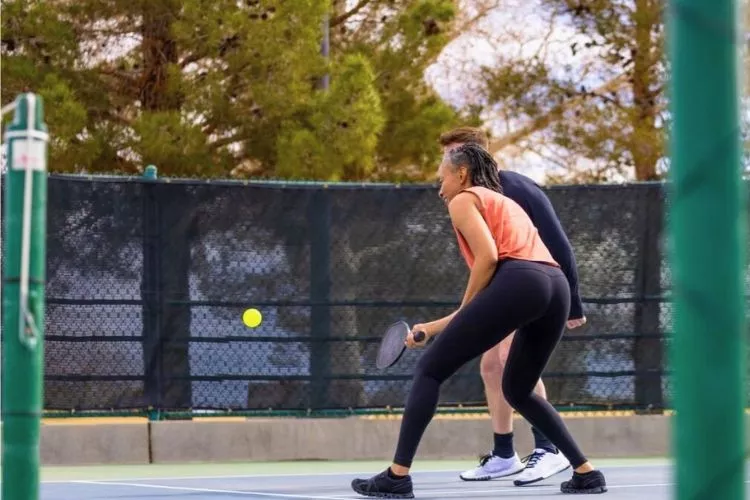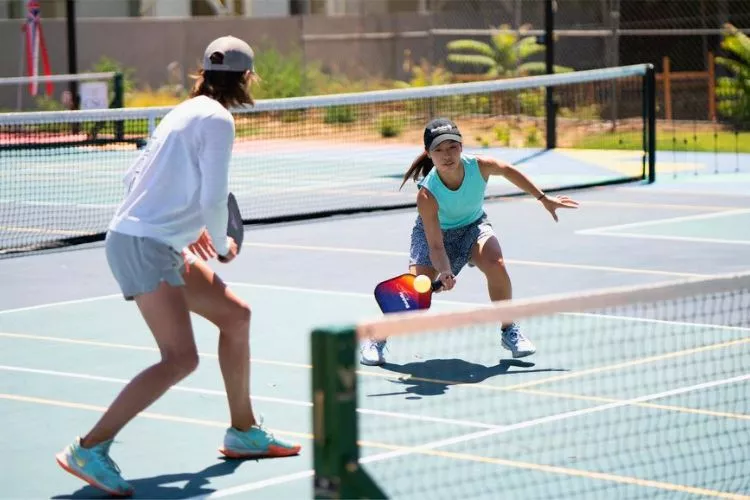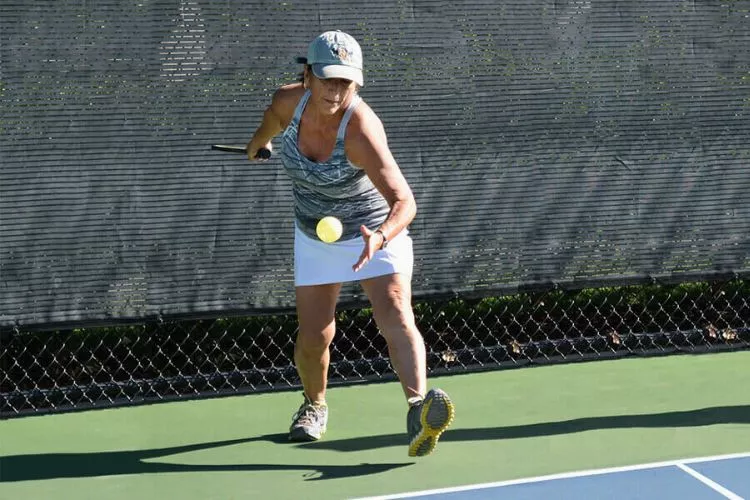Pickleball is an exhilarating sport that is growing in popularity. However, one skill that can be challenging for players is knowing how to keep the ball low in pickleball.
This is particularly important when playing near the net, where a high ball can give your opponents an advantage.

In this article, you will learn practical tips on how to keep the ball low in pickleball. By following these simple techniques, you will be able to make low shots with ease, giving you the edge over your opponents.
Whether you are a seasoned player or a beginner, read on to discover valuable insights that will help you improve your game.
How to keep the ball low in pickleball?
Keeping the ball low in pickleball requires a combination of technique, practice, and strategy. By implementing the tips outlined in this guide, you can enhance your skills and gain an upper hand on the court.
Remember to maintain a solid ready position, use a Continental grip, generate power from the legs, shorten your swing, follow-through at the net, play with soft hands, master the third shot drop, practice timing and footwork, understand spin, and play with intention.
With consistent practice and focus, you will soon master the art of keeping the ball low in pickleball.

Maintain a Solid Ready Position: To effectively keep the ball low, it is crucial to start with a solid ready position. Stand with your feet shoulder-width apart, knees slightly bent, and your weight balanced on the balls of your feet. This position allows you to move quickly and react to the ball instantly.
Use a Continental Grip: The grip plays a pivotal role in keeping the ball low. Utilize a Continental grip, where you place your paddle grip between the base knuckle of your index finger and the heel pad of your hand. This grip allows for better control, enabling you to make more controlled and precise shots.
Generate Power from the Legs: Power in pickleball comes from the legs, not just the arms. To keep the ball low, focus on using your legs to generate power for your shots. Bend your knees slightly and push off the ground with a quick, explosive motion to get low and hit the ball with a downward trajectory.
Shorten Your Swing: In order to keep the ball low, you should shorten your swing. A shorter swing reduces the chances of hitting the ball too high. Focus on a compact swing that starts from your ready position and ends with a snap of the wrist to create the necessary power and spin while maintaining a low trajectory.
Follow-Through at the Net: When hitting the ball near the net, it is essential to have a controlled follow-through. Ensure that your paddle finishes low close to the net after contact with the ball. This follow-through motion helps minimize the height of the shot, keeping it low and forcing your opponents to react quickly.
Play with Soft Hands: Keeping the ball low in pickleball often requires a soft touch. Rather than smacking the ball, focus on playing with soft hands. This means maintaining a relaxed grip and allowing the ball to bounce softly on the paddle. The softer contact will help keep the ball low and under better control.
Master the Third Shot Drop: The third shot drop is a crucial shot in pickleball that aims to keep the ball low and initiate proper positioning during the game. To execute this shot, hit the ball softly and with a high arch, allowing it to drop just over the net and bounce low in the kitchen or non-volley zone. This shot is effective in transitioning from the serve to an offensive position.
Practice Timing and Footwork: Timing and footwork are key to keeping the ball low consistently. Pay attention to the timing of your shots, meeting the ball at the highest point of its bounce. Additionally, practice your footwork to ensure you are in the right position to hit the ball low. This includes taking small, quick steps to adjust your position and get in an optimal stance.
Develop an Understanding of Spin: Understanding spin is essential for keeping the ball low in pickleball. Different spins, such as topspin or backspin, can affect the trajectory of the ball. Experiment with different spins to see how they impact the height of your shots. Developing control over spin will help you keep the ball low consistently.
Play with Intention: Lastly, always play with intention when trying to keep the ball low. Be mindful of your shots and aim for a specific target, such as the opponent’s side of the court or a low area near the net. By playing with intention, you will develop better shot placement and improve your ability to keep the ball low.
How do you return a low shot in pickleball?
Returning a low shot in pickleball requires quick reflexes, proper technique, and anticipation. Below is a detailed guide on how to effectively return a low shot in pickleball.

- Stay Low and Balanced: As soon as you see a low shot coming towards you, get into a low and balanced position. Bend your knees and adjust your stance to ensure stability. This will enable you to react quickly and maintain control over your return.
- Use a Continental Grip: Utilize a Continental grip on your paddle, which allows for better control and maneuverability. This grip involves placing your paddle grip between the base knuckle of your index finger and the heel pad of your hand.
- Watch the Ball Closely: Keep your eyes focused on the ball at all times. As the ball approaches, concentrate on its speed, trajectory, and bounce. This will help you anticipate and react to the shot efficiently.
- Keep Your Paddle Face Open: When returning a low shot, it is crucial to keep your paddle face open. Tilt the face of your paddle upward slightly to create an upward angle of contact with the ball. This angle will help lift the ball and keep it low over the net.
- Shorten Your Swing: To effectively return a low shot in pickleball, shorten your swing. A shorter swing allows for quick and precise contact with the ball. Focus on a compact swing that starts from your ready position and ends with a flick of the wrist.
- Generate Power from Your Legs: Power in your return shot should come from your legs, not just your arm. Use your legs to generate power by pushing off the ground with a quick and explosive motion. This helps you get low to the ball and adds power and control to your return.
- Use the Bounce to Your Advantage: Allow the ball to bounce low before returning it. Timing your return to hit the ball as it rises from the bounce helps keep your shot low and avoids hitting it into the net.
- Control the Pace of Your Return: Depending on the situation, you may want to control the pace of your return shot. A soft and controlled return can keep the ball low and force your opponents into a defensive position. Alternatively, a faster and more aggressive shot can catch your opponents off guard.
- Anticipate the Opponent’s Next Move: As you return a low shot, try to anticipate where your opponent will hit the ball next. Keep an eye on their positioning and body language to prepare for your subsequent shot.
- Practice and Adapt: Returning low shots effectively requires practice and adaptability. Work on your reflexes, footwork, and timing by engaging in drills and playing matches. Adjust your technique based on the level and style of your opponents, as different players may require different strategies.
By following these tips, you will enhance your ability to return low shots in pickleball.
Remember to maintain a low and balanced position, use a Continental grip, watch the ball closely, keep your paddle face open, shorten your swing, generate power from your legs, use the bounce to your advantage, control the pace of your return, anticipate your opponent’s next move, and practice with adaptability.
With time and practice, you will become a proficient player in returning low shots and gain an advantage over your opponents on the pickleball court.
How do you serve a low serve in pickleball?
Serving a low serve in pickleball requires precision, control, and a strategic approach. Here is a detailed guide on how to effectively execute a low serve in pickleball.

- Position Yourself Correctly: Begin by standing behind the baseline, with your feet shoulder-width apart. Maintain a balanced and relaxed posture to ensure stability during your serve.
- Hold the Paddle Correctly: Employ a Continental grip on your paddle for better control and accuracy. This grip involves placing the base knuckle of your index finger and the heel pad of your hand on the paddle grip.
- Choose the Right Target: Determine your target before serving. Aim to hit the ball low and close to the centerline of the court, ideally in the no-volley zone (kitchen). This target provides challenging shots for your opponent and increases the chances of a successful low serve.
- Use a Compact Motion: Keep your serving motion compact to maximize control and accuracy. Start with a small backswing, limited to waist height, and bring your paddle forward smoothly, making contact with the ball at hip level.
- Execute a Controlled Toss: Hold the ball with a relaxed hand and toss it slightly in front of you and upwards. Aim for a toss that reaches roughly eye-level, allowing you to hit the ball when it is at its highest point. A controlled toss aids in timing and consistency.
- Generate Power from Your Legs: Power in your low serve comes from your legs, rather than just your arm. Bend your knees slightly and push off the ground with a quick and explosive motion as you make contact with the ball. This leg drive adds power and helps keep the ball low.
- Maintain a Flat Paddle Face: To execute a low serve, ensure that your paddle face is flat and parallel to the ground upon contact with the ball. This allows you to keep the ball trajectory low and controlled, making it more challenging for your opponent to return.
- Focus on Spin Control: In addition to keeping the ball low, adding spin to your serve can enhance its effectiveness. Experiment with different types of spins such as topspin or backspin to keep the ball low and create variation in your serves.
- Follow Through Smoothly: After making contact with the ball, follow through smoothly and consistently. Allow your arm to extend towards your target while maintaining control and balance. This disciplined follow-through ensures accuracy and keeps the ball low.
- Practice with Focus: To improve your low serve, practice with intention and focus. Set aside dedicated time for serving drills, aiming for consistent placement and control. Additionally, practice varying the speed and spin of your serves to keep your opponents off balance.
You can execute a low serve effectively in pickleball. Position yourself correctly, hold the paddle correctly, choose the right target, use a compact motion, execute a controlled toss, generate power from your legs, maintain a flat paddle face, focus on spin control, follow through smoothly, and practice with focus.
With practice and dedication, your low serve will become a reliable weapon in your pickleball arsenal.
Conclusion:
Keeping the ball low in pickleball is essential for maintaining control, putting pressure on your opponents, and increasing the chances of winning a point.
By following the tips outlined in this article, such as maintaining a low stance, using a Continental grip, watching the ball closely, keeping your paddle face open, and generating power from your legs, you can effectively keep the ball low in pickleball.
Remember to practice these techniques regularly to improve your skills and become a more formidable player on the court. With dedication and perseverance, you will master the art of keeping the ball low and gain a competitive edge in your pickleball game.

Pickleball’s more than a game to me—it’s a passion. I write, sharing its highs and lows, the thrills and the lessons. Some tales might draw you to the court, while others give a hint of the game’s magic. So, curious about my journey? Ready to dive deep into the world of pickleball with me? Let’s go.
